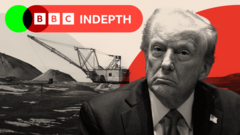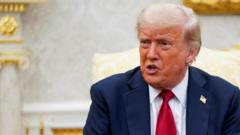As Trump returns to the political forefront, his focus on securing critical minerals may open new avenues for U.S. green technology. However, concerns about the effectiveness of U.S. supply chains and its late entry into the sector remain pivotal.
Trump's Mineral Deals: A Dual Pathway to Economic Gain and Green Growth?

Trump's Mineral Deals: A Dual Pathway to Economic Gain and Green Growth?
Exploring former President Trump's focus on critical minerals and its implications for both the economy and green technology.
The recent resurgence of Donald Trump in the political arena has raised eyebrows among environmental advocates, continuing a wave of concern about the impact on global climate initiatives. Following his return to the White House, former UN climate chief Christiana Figueres lamented the implications for global climate action, pointing to Trump's withdrawal from the Paris Climate Agreement and rejection of robust environmental policies, including advancements in renewable energy technologies.
However, amidst the skepticism lies a potentially progressive angle: Trump's keen interest in brokering agreements for critical minerals with global partners such as Ukraine, Greenland, and Canada. These minerals, crucial in industries from aerospace to clean energy technologies, represent both economic opportunity and a strategic essential for the U.S. as the world pivots towards sustainable solutions.
For instance, major players like Elon Musk, whose companies are heavily reliant on these minerals for electric vehicles and battery production, underscore their critical importance. Demand for such resources surged in 2023, particularly lithium which saw a dramatic 30% increase driven by the booming electric vehicle sector. The International Energy Agency’s projections indicate that in the coming years, these minerals will become indispensable to the clean energy transition.
However, the U.S. sits at a precarious juncture in the global market for rare earth elements, with China currently dominating both the supply and processing segments. Analysts note that the U.S.’s dependency on China poses risks to its defense and tech industries, a situation that could be alleviated if Trump’s administration pivots towards bolstering domestic mineral sourcing.
While the Biden administration has dedicated substantial investment—amounting to nearly $493 billion—in green technology through the Inflation Reduction Act, many industry experts contend that enhancing upstream processes, like mining and processing critical minerals, has been sidelined. Trump's recent initiatives may reflect a changing focus towards securing these mineral supply chains, arguably at a time when climate movements are echoing calls for clean energy investments.
However, skepticism remains about the timeline required to build effective mineral supply chains in the U.S. Experts project it can take up to a decade before any new mining operations yield significant results. As the administration considers a potential "Critical Minerals Executive Order", the details remain critical. Streamlined processes for mining permits could hasten the U.S.'s competitive stance against global players, especially if market dynamics continue shifting towards electric vehicles and sustainable technologies.
Despite Trump's less environmentally-friendly legacy, his approach towards critical minerals connects economic strategy with opportunistic advantage in the green sector. Whether this strategy will solidify support among eco-conscious constituents remains uncertain as impending elections put pressure on policy direction. The next steps in this evolving narrative will be crucial not only for Trump's political trajectory but also for shaping the future of U.S. green technology as the world keenly watches.
However, amidst the skepticism lies a potentially progressive angle: Trump's keen interest in brokering agreements for critical minerals with global partners such as Ukraine, Greenland, and Canada. These minerals, crucial in industries from aerospace to clean energy technologies, represent both economic opportunity and a strategic essential for the U.S. as the world pivots towards sustainable solutions.
For instance, major players like Elon Musk, whose companies are heavily reliant on these minerals for electric vehicles and battery production, underscore their critical importance. Demand for such resources surged in 2023, particularly lithium which saw a dramatic 30% increase driven by the booming electric vehicle sector. The International Energy Agency’s projections indicate that in the coming years, these minerals will become indispensable to the clean energy transition.
However, the U.S. sits at a precarious juncture in the global market for rare earth elements, with China currently dominating both the supply and processing segments. Analysts note that the U.S.’s dependency on China poses risks to its defense and tech industries, a situation that could be alleviated if Trump’s administration pivots towards bolstering domestic mineral sourcing.
While the Biden administration has dedicated substantial investment—amounting to nearly $493 billion—in green technology through the Inflation Reduction Act, many industry experts contend that enhancing upstream processes, like mining and processing critical minerals, has been sidelined. Trump's recent initiatives may reflect a changing focus towards securing these mineral supply chains, arguably at a time when climate movements are echoing calls for clean energy investments.
However, skepticism remains about the timeline required to build effective mineral supply chains in the U.S. Experts project it can take up to a decade before any new mining operations yield significant results. As the administration considers a potential "Critical Minerals Executive Order", the details remain critical. Streamlined processes for mining permits could hasten the U.S.'s competitive stance against global players, especially if market dynamics continue shifting towards electric vehicles and sustainable technologies.
Despite Trump's less environmentally-friendly legacy, his approach towards critical minerals connects economic strategy with opportunistic advantage in the green sector. Whether this strategy will solidify support among eco-conscious constituents remains uncertain as impending elections put pressure on policy direction. The next steps in this evolving narrative will be crucial not only for Trump's political trajectory but also for shaping the future of U.S. green technology as the world keenly watches.




















